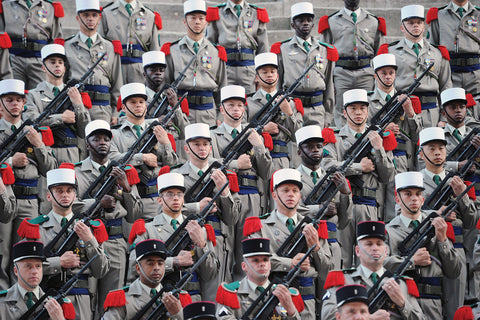
The Foreign Legion in Photos
A year after France invaded Algeria in 1830, it created a special army formation to seize and hold its growing empire in Africa. Aside from French officers, its ranks were open to volunteers of any nationality, who could serve France without losing their original citizenship. From the outset these mercenaries proved outstanding soldiers, achieving truly legendary status with their stalwart stand against impossible odds at Camarón, Mexico, on April 30, 1863. The legion soon added other hard-earned battle streamers with iconic names to its regimental standards, such as Tuyên Quang, Indochina (1884–85) and Bir Hakeim, Libya (1942). During World War I the legion fielded thousands of ground troops, and hundreds of its foreign volunteers were permitted to transfer into aviation, including the mostly American escadrille N.124 “Lafayette.”
Foreign Legion loyalties could get politically heated. In World War II legionnaires—some loyal to the Vichy government, others to the Free French exiles under Gen. Charles de Gaulle—sometimes fought each other. When de Gaulle’s postwar government decided to withdraw from Algeria, many legionnaires joined those who rose in opposition. In the wake of the resulting 1961 “Algiers putsch” and various acts of sabotage and assassination, however, de Gaulle remembered the legion’s World War II service and did not completely disband it, instead downsizing it from 40,000 to 8,000 men.
Since then the Foreign Legion has continued to uphold its status as an elite force of troubleshooters, sent wherever French interests require. Although it has had to abandon its original Algerian headquarters for metropolitan France, most of its 21st century exploits still center on Africa, such as Operation Serval in northern Mali in 2013–14.
Building a Legend
Moving from Algerian desert patrols to major combat
during the Crimean War, the Foreign Legion participates in the Sept. 8, 1855,
Battle of Malakoff, in a painting by Adolphe Yvon. (Château de Versailles)
Captain Jean
Danjou commanded the legionnaires to his own death at Camarón on April 30,
1863. (Roger-Viollet (Granger))
Danjou’s wooden hand, recovered from Camarón,
is on display at the Foreign Legion Museum in Aubagne. (Jean-Pierre Laffont)
Lieutenant Colonel Paul-Frédéric Rollet (center)
stands with fellow soldiers of the Marching Regiment of the Foreign Legion in
1918. (Print Collector (Getty))
Free French legionnaires
assault an Axis strongpoint near Bir Hakeim, Libya, in June 1942. (Imperial
War Museums)
Upholding the Edifice
Back full circle, legionnaires patrol the Sahara
Desert in the 1950s against a new enemy—the Algerian National Liberation
Front. (Keystone-France (Getty Images))
Airborne
legionnaires arrive to reinforce the base at Dien Bien Phu, French Indochina,
in 1953. (Popperfoto (Getty))
Members of the famous 13th
Demi-Brigade of the Foreign Legion patrol in Djibouti in December 1983.
(Gysembergh Benoit (Getty))
New recruits in the 4th Foreign
Regiment learn the steps amid 15 weeks of arduous training at Castelnaudary,
France. (José Nicolas (Getty))
A sniper of the 2nd Foreign Infantry Regiment takes
aim with his GIAT FR F2 rifle in the mountains of Afghanistan in 2005.
(davric, CC BY-SA 3.0)
this article first appeared in Military History magazine
Facebook @MilitaryHistoryMagazine | Twitter @MilHistoryMag
